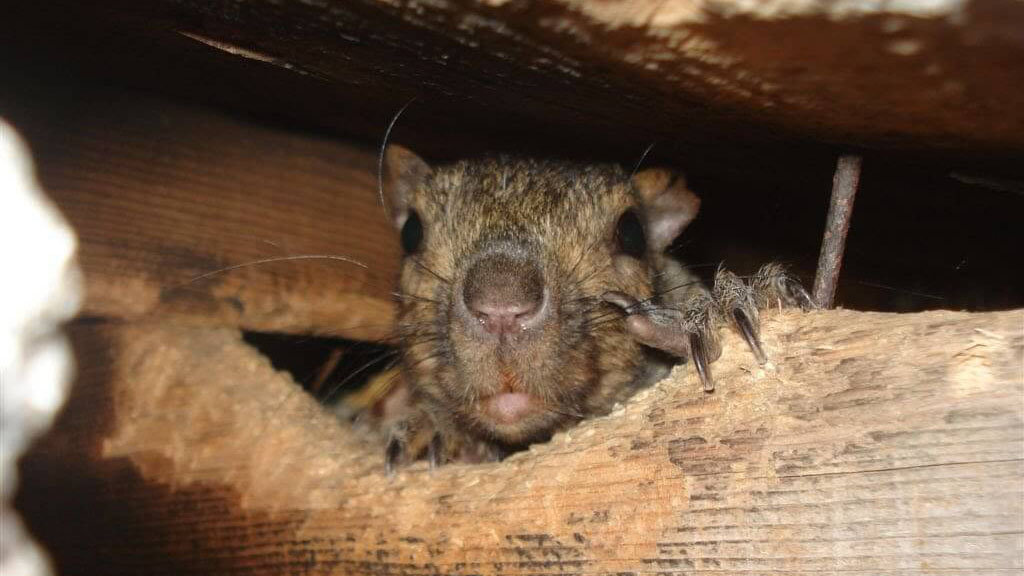SQUIRREL REMOVAL PROCESS
Assess and Remove
Our comprehensive 50 point home inspection is designed to determine squirrel entry points and home damage. The attic is a common den site for squirrels where they gain access by chewing holes or slipping in between building materials. We then use hands-on removal techniques to humanely evict the squirrels.
Clear and Clean
Squirrels are notorious for creating large, messy nests within their den site and causing damage through chewing. Skedaddle will thoroughly clear away any nesting material and debris from the den and clean up the mess left behind. We can also replace soiled insulation and damaged ductwork if required.
Prevent and Protect
Our final step is making sure your home is protected, not only against the current intruders, but all the other squirrels in your neighbourhood. To keep them out we will secure the entry points we identified, as well any other potential vulnerabilities.
Squirrel Removal Hamilton
Both the gray and red squirrel are found throughout Hamilton and the surrounding areas. Anyone who has spent time in the city knows that the grey squirrel, which can also be black or brown, is far more common. Red squirrels tend to be found primarily in areas with many coniferous (evergreen) trees, because the seeds from the trees’ cones form a large part of their diet. The Dundas Valley, where coniferous trees grow tall and strong is home to a thriving red squirrel population.
These rodents typically build nests on bare tree branches high above the ground. They can, however, end up in your home, making their way into attics and sometimes traveling down walls. Once they’ve established themselves, their chewing habits can cause a significant amount of damage to an attic and electrical wires, and their presence can pose a health hazard. Evicting squirrels requires the expertise of Skedaddle’s professional Hamilton squirrel removal team.
Best Nesting Spots for Hamilton Squirrels
If you’ve spotted a squirrel in the city, you’ll know how much they love their time in the trees. For squirrels in Hamilton, trees provide food, safe travel and nesting opportunities in an urban setting. The more mature and dense the tree population in your neighbourhood, the more squirrels are able to thrive and potentially make their way into your attic. While squirrels are found throughout the city, their numbers are greatest in Hamilton’s older neighbourhoods, like Durand, Kirkendall, and Westdale, where mature tree canopies are the norm and their access to roofs is easiest.
Homeowners living in new housing developments like parts of Stoney Creek Mountain, Glanbrook and Binbrook, where mature trees have been taken down and replaced with saplings tend to experience far fewer problems with squirrels getting into their attics in the years immediately following construction.
Many of the old Victorian homes in Hamilton’s lower city neighbourhoods have more exposed wood fascias and soffits as compared to modern construction where aluminum is preferred. Exposed wood is easily susceptible to the chewing of determined squirrels that have easier access to roofs in older communities because of trees and overhead wires. The height and steep sloped roofs of Hamilton’s century homes make them dangerous to climb to identify and repair squirrel entry points without the proper safety equipment and training. These areas are often surrounded by electrical wires that squirrels use as a highway to travel from roof to roof with ease. Our technicians arrive at each wildlife removal in Hamilton prepared with the necessary equipment to safely access the highest points of a home to identify and repair squirrel entries.
Once squirrels have chewed their way into an attic they are capable of causing tremendous damage through their activity and chewing. They are most often heard by homeowners in the early morning as the sun rises when they wake up and begin their day. Spring and summer is when female squirrels have babies and are most likely to seek out the shelter of an attic. The space above the ceiling offers them an ideal place to stash away babies until they are old enough to leave the nest on their own.
Finding and removing immobile squirrel babies takes skill and experience. They need to be removed by hand because they are too young to be trapped or chased out. Failing to take babies into account when removing squirrels could lead to needless additional damage or an inhumane death for the mother and babies. Skedaddle’s team of squirrel removal experts offer customized removal services that will ensure mothers and their babies are removed together and prevented from re-entering. Hamilton homeowners have trusted our squirrel removal techniques and high level customer service since 1989.
Feeding City Squirrels Creates Problems
Many Hamilton residents love to feed the squirrels that run through their backyard. While it might seem like a pretty innocent or even helpful gesture, feeding wildlife is discouraged by the City of Hamilton. By-law No.12-130 prohibits the feeding of wildlife in Hamilton, with a fine of up to $10,000. Repeat offenders could see a fine as large as $25,000. The aim of the by-law is to not only protect wildlife populations, but also prevent wildlife overpopulation which can lead to conflict.
The size of any wildlife population in a given area is determined largely by the amount of food, water and shelter that area can support. Squirrels are well adapted to the urban environment and can find themselves with more food and shelter options than they would otherwise experience in nature. Hamilton is no different, when humans deliberately feed wildlife or do so by accident, the result can be an explosion in population size. Food sources attract squirrels and well-fed squirrels live longer and have more babies.
All those squirrels need somewhere to sleep at night – leading them into attics, chimneys and garages. Our partnerships with the Hamilton/Burlington SPCA as well as the Burlington Humane Society give us the opportunity to educate community members on the risks associated with feeding wildlife and the importance of humane wildlife control.
Squirrel Facts
The squirrels we see in Hamilton are typically most active during the daylight hours. They spend a lot of their time foraging for food. During the fall, they work to build up their stores of food in the fat on their bodies and bury food in holes in the ground. During winter, they rely on these fat reserves to help them survive. The fat on their body keeps them going when it is too cold to be out collecting the food they’ve buried.
FACT:
Their nests are constructed from twigs, leaves and grass. They’ll also chew whatever they find in your house, including wiring — which creates a fire hazard — insulation, and framing. Part of Skedaddle’s humane wildlife control process involves an assessment of damages and recommendations for what repairs are needed.
FACT:
Squirrels are rodents, and, like others in the order Rodentia, their teeth never stop growing. Since they use their teeth extensively, their incisors are in a constant cycle of wear and growth.
FACT:
There are over 200 species of squirrels in the world. They are found on every continent except Australia and Antarctica. In Ontario, there are only four different species of squirrels. The four species are; eastern grey squirrels, red squirrels, fox squirrels and flying squirrels.
FACT:
Flying squirrels don’t really fly; they glide. Their adaptation is ideal for tree life but makes them vulnerable on the ground. In addition to flying squirrels, Hamilton is also home to the eastern grey squirrel, fox squirrel and red squirrels.
FACT:
Females give birth to litters twice per year, with up to six pups per litter. In Hamilton baby squirrels normally begin to arrive by early March. Babies are weaned after 10 weeks of nursing, but they’ll stick with mom for a few more weeks to learn the ropes of foraging.
FACT:
Squirrels are not typically aggressive toward humans, though a mother squirrel is very protective of her young. If she feels threatened or is separated from her offspring, she may behave aggressively by barking, flicking her tail or charging toward a threat.
CHECK OUT OUR LATEST BLOGS
Can Squirrels Spread Parasites? What You Need to Know
Attic Acrobats: How Squirrels Use Tree Branches to Access Your Roof
Should You Feed Squirrels In The Winter Months?
Hamilton Wildlife Control: The Secret Life of a Squirrel’s Social Structure
Hamilton Wildlife Control: Why do Squirrels Suddenly Stop?






